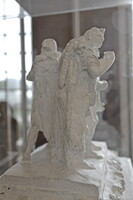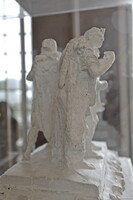| dc.coverage.spatial | Site: Musée Rodin (Paris, Île-de-France, France) S.86 | en_US |
| dc.coverage.temporal | 1884 (creation) | en_US |
| dc.creator | Rodin, Auguste | en_US |
| dc.date | 1884 | en_US |
| dc.date.accessioned | 2015-01-06T15:09:23Z | |
| dc.date.available | 2015-01-06T15:09:23Z | |
| dc.date.issued | 1884 | en_US |
| dc.identifier | 256239 | en_US |
| dc.identifier.other | archrefid: 3017 | en_US |
| dc.identifier.uri | http://hdl.handle.net/1721.3/172191 | |
| dc.description | Detail, figures from the left side; In 1347, after a year-long siege, six citizens of Calais agreed to sacrifice their lives and hand over the keys of their city to its conqueror, King Edward III of England. The story was related in Jean Froissart’s Chronicles (1370-1400). Although commissioned to depict only the leading burgher, Eustache de St Pierre, Rodin decided to show all six in a "slow procession towards death". The notion of collective sacrifice was emphasized even in the first maquette. The six figures, not yet individualized, were presented on the same plane on a very high rectangular base, adorned with bas-reliefs, which formed a triumphal pedestal. This first maquette was greeted enthusiastically by the committee and Rodin was officially awarded the commission. Source: Musée Rodin [website]; http://www.musee-rodin.fr/en/ (accessed 5/13/2014) | en_US |
| dc.format.medium | plaster | en_US |
| dc.rights | © Scott Gilchrist, Archivision, Inc. | en_US |
| dc.subject | historical | en_US |
| dc.subject | human figure | en_US |
| dc.subject | military or war | en_US |
| dc.subject | Hundred Years War | en_US |
| dc.subject | Nineteenth century | en_US |
| dc.title | Burghers of Calais [First Maquette] | en_US |
| dc.type | image | en_US |
| dc.rights.access | Licensed for educational and research use by the MIT community only | en_US |
| dc.identifier.vendorcode | 7A1-RA-RBCS-A18 | en_US |
| vra.culturalContext | French | en_US |
| vra.technique | modeling (forming) | en_US |
| vra.worktype | maquette (sculpture) | en_US |
| dc.contributor.display | Auguste Rodin (French sculptor, 1840-1917) | en_US |


